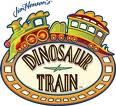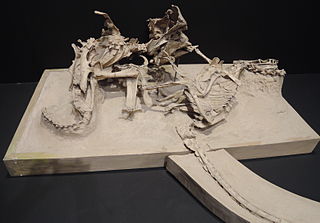
Tyrannosaurus is a genus of large theropod dinosaur. The type species Tyrannosaurus rex, often shortened to T. rex or colloquially T-Rex, is one of the best represented theropods. It lived throughout what is now western North America, on what was then an island continent known as Laramidia. Tyrannosaurus had a much wider range than other tyrannosaurids. Fossils are found in a variety of rock formations dating to the latest Campanian-Maastrichtian ages of the late Cretaceous period, 72.7 to 66 million years ago. It was the last known member of the tyrannosaurids and among the last non-avian dinosaurs to exist before the Cretaceous–Paleogene extinction event.

Velociraptor is a genus of small dromaeosaurid dinosaurs that lived in Asia during the Late Cretaceous epoch, about 75 million to 71 million years ago. Two species are currently recognized, although others have been assigned in the past. The type species is V. mongoliensis, named and described in 1924. Fossils of this species have been discovered in the Djadochta Formation, Mongolia. A second species, V. osmolskae, was named in 2008 for skull material from the Bayan Mandahu Formation, China.

Ankylosaurus is a genus of armored dinosaur. Its fossils have been found in geological formations dating to the very end of the Cretaceous Period, about 68–66 million years ago, in western North America, making it among the last of the non-avian dinosaurs. It was named by Barnum Brown in 1908; it is monotypic, containing only A. magniventris. The generic name means "fused" or "bent lizard", and the specific name means "great belly". A handful of specimens have been excavated to date, but a complete skeleton has not been discovered. Though other members of Ankylosauria are represented by more extensive fossil material, Ankylosaurus is often considered the archetypal member of its group, despite having some unusual features.

Protoceratops is a genus of small protoceratopsid dinosaurs that lived in Asia during the Late Cretaceous, around 75 to 71 million years ago. The genus Protoceratops includes two species: P. andrewsi and the larger P. hellenikorhinus. The former was described in 1923 with fossils from the Mongolian Djadokhta Formation, and the latter in 2001 with fossils from the Chinese Bayan Mandahu Formation. Protoceratops was initially believed to be an ancestor of ankylosaurians and larger ceratopsians, such as Triceratops and relatives, until the discoveries of other protoceratopsids. Populations of P. andrewsi may have evolved into Bagaceratops through anagenesis.

Extreme Dinosaurs is an American animated series produced by DIC Productions, L.P. and Bohbot Entertainment in 1997 based on a 1996 toy line from Mattel. This show is a spin-off of Street Sharks.
Cretaceous Mongolia is one of the strangest and best preserved of all Mesozoic ecosystems. The shifting sand of what was, even then, the Gobi Desert have ensured that fossils of the animals that lived there can be found in exactly the position in which they were buried, with most of the bones together. The most notable fossil, dubbed the Fighting Dinosaurs, is the very well preserved remains of a Velociraptor, locked in combat with a Protoceratops, a small ceratopsian.

Leptoceratops is a genus of ceratopsian dinosaur from the Late Cretaceous of North America. First found in Alberta in 1910, the type species Leptoceratops gracilis was named in 1914 by Barnum Brown for a partial skull and skeleton of two individuals found in the Scollard Formation of Alberta. Additional specimens found in the Scollard include one complete and two mostly complete skeletons together, uncovered in 1947 by Charles M. Sternberg. Specimens from Montana that were among the earliest referred to Leptoceratops have since been moved to their own genera Montanoceratops and Cerasinops, while new specimens of L. gracilis include bonebed remains from the Hell Creek Formation of Montana and a partial skeleton from the Lance Formation of Wyoming. Together with related taxa, Leptoceratops is the eponymous genus of the family Leptoceratopsidae. Leptoceratops is known from more than ten individuals, all from Maastrichtian deposits of Alberta, Montana and Wyoming, representing the entire skeleton.

Tyrannosaurus rex is unique among dinosaurs in its place in modern culture; paleontologist Robert Bakker has called it "the most popular dinosaur among people of all ages, all cultures, and all nationalities". Paleontologists Mark Norell and Lowell Dingus have likewise called it "the most famous dinosaur of all times." Paleoartist Gregory S. Paul has called it "the theropod. [...] This is the public's favorite dinosaur [...] Even the formations it is found in have fantastic names like Hell Creek and Lance." Other paleontologists agree with that and note that whenever a museum erects a new skeleton or bring in an animatronic model, visitor numbers go up. "Jurassic Park and King Kong would not have been the same without it." In the public mind, T. rex sets the standard of what a dinosaur should be. Science writer Riley Black similarly states, "In all of prehistory, there is no animal that commands our attention quite like Tyrannosaurus rex, the king of the tyrant lizards. Since the time this dinosaur was officially named in 1905, the enormous carnivore has stood as the ultimate dinosaur."

Armour or armor in animals is a rigid cuticle or exoskeleton that provides exterior protection against attack by predators, formed as part of the body usually through the thickening and hardening of superficial tissues, outgrowths or skin secretions. It is often found in prey species that are too slow or clumsy to outrun predators, or those that would stand their ground and fight, thus needing to shield vital organs against claw, talon or bite injuries.

Stegosaurus is one of the most recognizable types among cultural depictions of dinosaurs. It has been depicted on film, in cartoons, comics, as children's toys, as sculpture, and even was declared the state dinosaur of Colorado in 1982. Stegosaurus is a subject for inclusion in dinosaur toy and scale model lines, such as the Carnegie Collection.
Dinosaur Walk Museum was a series of attractions that feature life-size sculptures of dinosaurs and replicas of fossils. Branches of the museum were located in Riverhead, New York and Pigeon Forge, Tennessee.

Dinosaur Train is an animated television series aimed at preschoolers ages 3 to 6 and created by Craig Bartlett, who also created Nickelodeon's Hey Arnold!. The series features a Tyrannosaurus rex named Buddy who, together with the rest of his family, who are all Pteranodons, takes the Dinosaur Train to explore the Mesozoic, and have adventures with a variety of dinosaurs. It is co-produced by The Jim Henson Company in association with the Infocomm Media Development Authority, Sparky Animation, FableVision, Snee-Oosh, Inc., Reel FX, and Sea to Sky Entertainment. As of September 2018, PBS Kids had ordered 11 more episodes, taking the total number of episodes to 100. A film based on the series from Universal Pictures and Universal 1440 Entertainment titled, Dinosaur Train: Adventure Island premiered on April 12, 2021.
Last Day of the Dinosaurs is a 2010 Discovery Channel television documentary about the K-T extinction, which resulted in the extinction of the non-avian dinosaurs. It portrays the Alvarez hypothesis as the cause of extinction. The documentary was released on August 28, 2010 and narrated by Bill Mondy.

The Fighting Dinosaurs is a fossil specimen which was found in the Late Cretaceous Djadokhta Formation of Mongolia in 1971. It preserves a Protoceratops andrewsi and Velociraptor mongoliensis trapped in combat about 74 million years ago and provides direct evidence of predatory behavior in non-avian dinosaurs. The specimen has caused much debate as to how both animals came to be preserved together with relative completeness. Several hypotheses have been proposed, including a drowning scenario, burial by either dune collapse or sandstorm, or alternatively they were not buried simultaneously.
You Are Umasou is a Japanese picture book series by Tatsuya Miyanishi, published by Poplar. The series has spawned three animated film adaptations.
Dinofroz is an Italian animated series made by Giochi Preziosi in partnership with the Italian studio Mondo TV.

The feeding behaviour of Tyrannosaurus rex has been studied extensively. The well known attributes of T. rex are often interpreted to be indicative of either a predatory or scavenging lifestyle, and as such the biomechanics, feeding strategies and diet of Tyrannosaurus have been subject to much research and debate.
Dinosaurs is a set of miniatures published by Grenadier subsidiary Pinnacle Products.

The Dueling Dinosaurs or Montana Dueling Dinosaurs is a fossil specimen originating from the Hell Creek Formation of Montana. It consists of the fossilized skeletons of a tyrannosaur and a Triceratops horridus entangled with one another and entombed in sandstone. This is identical to the Fighting Dinosaurs, an 74-million-year-old specimen found in 1971 Mongolia where a Velociraptor and Protoceratops were locked in battle and preserved. The "dueling" inference comes from the numerous injuries sustained by both dinosaurs, including a tooth from the tyrannosaur embedded within the Triceratops, although it is not known whether they were actually buried fighting one another. Tyrannosaurus rex was a 40 ft. long carnivore weighing 10 tons and ruled the Cretaceous period with strong jaws and sharp teeth to tear up to 500 pounds of flesh and bone in a single bite. Triceratops was bigger than an elephant and was notified by a rounded skull with horns and a bony frill to intimidate and defend against predators. Despite the scientific importance of the specimen, it remained obscure for decades due to a lengthy legal dispute over property rights to the specimen, which has since been resolved. The fossil is in the possession of and being studied by the North Carolina Museum of Natural Sciences, where it went on display in 2024.














